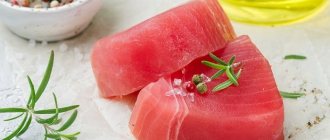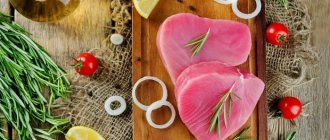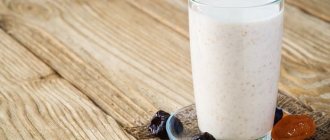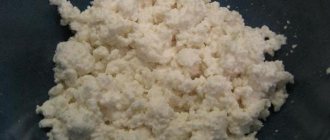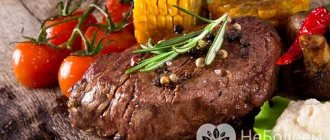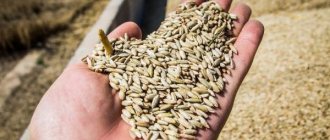Nutritional value and chemical composition of “Salted salmon”.
| Nutrient | Quantity | Norm** | % of the norm in 100 g | % of the norm in 100 kcal | 100% normal |
| Calorie content | 202 kcal | 1684 kcal | 12% | 5.9% | 834 g |
| Squirrels | 22.5 g | 76 g | 29.6% | 14.7% | 338 g |
| Fats | 12.5 g | 56 g | 22.3% | 11% | 448 g |
| Water | 56.5 g | 2273 g | 2.5% | 1.2% | 4023 g |
| Ash | 8.5 g | ||||
| Vitamin B1, thiamine | 0.15 mg | 1.5 mg | 10% | 5% | 1000 g |
| Vitamin B2, riboflavin | 0.2 mg | 1.8 mg | 11.1% | 5.5% | 900 g |
| Vitamin B4, choline | 0.731 mg | 500 mg | 0.1% | 68399 g | |
| Vitamin B5, pantothenic | 1.6 mg | 5 mg | 32% | 15.8% | 313 g |
| Vitamin B6, pyridoxine | 0.8 mg | 2 mg | 40% | 19.8% | 250 g |
| Vitamin B9, folates | 25 mcg | 400 mcg | 6.3% | 3.1% | 1600 g |
| Vitamin B12, cobalamin | 3 mcg | 3 mcg | 100% | 49.5% | 100 g |
| Vitamin C, ascorbic acid | 1 mg | 90 mg | 1.1% | 0.5% | 9000 g |
| Vitamin D, calciferol | 10.2 mcg | 10 mcg | 102% | 50.5% | 98 g |
| Vitamin E, alpha tocopherol, TE | 2.5 mg | 15 mg | 16.7% | 8.3% | 600 g |
| Vitamin K, phylloquinone | 0.5 mcg | 120 mcg | 0.4% | 0.2% | 24000 g |
| Vitamin RR, NE | 10 mg | 20 mg | 50% | 24.8% | 200 g |
| Niacin | 6.2 mg | ||||
| Macronutrients | |||||
| Potassium, K | 221 mg | 2500 mg | 8.8% | 4.4% | 1131 g |
| Calcium, Ca | 40 mg | 1000 mg | 4% | 2% | 2500 g |
| Magnesium, Mg | 60 mg | 400 mg | 15% | 7.4% | 667 g |
| Sodium, Na | 2970 mg | 1300 mg | 228.5% | 113.1% | 44 g |
| Sera, S | 225 mg | 1000 mg | 22.5% | 11.1% | 444 g |
| Phosphorus, P | 243 mg | 800 mg | 30.4% | 15% | 329 g |
| Chlorine, Cl | 4477 mg | 2300 mg | 194.7% | 96.4% | 51 g |
| Microelements | |||||
| Iron, Fe | 2.5 mg | 18 mg | 13.9% | 6.9% | 720 g |
| Yod, I | 50 mcg | 150 mcg | 33.3% | 16.5% | 300 g |
| Cobalt, Co | 20 mcg | 10 mcg | 200% | 99% | 50 g |
| Manganese, Mn | 0.05 mg | 2 mg | 2.5% | 1.2% | 4000 g |
| Copper, Cu | 250 mcg | 1000 mcg | 25% | 12.4% | 400 g |
| Molybdenum, Mo | 4 mcg | 70 mcg | 5.7% | 2.8% | 1750 g |
| Nickel, Ni | 6 mcg | ||||
| Selenium, Se | 36.5 mcg | 55 mcg | 66.4% | 32.9% | 151 g |
| Fluorine, F | 430 mcg | 4000 mcg | 10.8% | 5.3% | 930 g |
| Chromium, Cr | 55 mcg | 50 mcg | 110% | 54.5% | 91 g |
| Zinc, Zn | 0.7 mg | 12 mg | 5.8% | 2.9% | 1714 g |
| Sterols (sterols) | |||||
| Cholesterol | 108 mg | max 300 mg | |||
| Saturated fatty acids | |||||
| Saturated fatty acids | 2.3 g | max 18.7 g | |||
| Monounsaturated fatty acids | 4.15 g | min 16.8 g | 24.7% | 12.2% | |
| Polyunsaturated fatty acids | 5.11 g | from 11.2 to 20.6 g | 45.6% | 22.6% | |
| Omega-3 fatty acids | 4.14 g | from 0.9 to 3.7 g | 111.9% | 55.4% | |
| Omega-6 fatty acids | 0.864 g | from 4.7 to 16.8 g | 18.4% | 9.1% |
The energy value of salted salmon is 202 kcal.
Main source: Skurikhin I.M. and others. Chemical composition of food products. Read more.
** This table shows the average levels of vitamins and minerals for an adult. If you want to know the norms taking into account your gender, age and other factors, then use the “My Healthy Diet” application.
How to choose fresh, lightly salted and salted fish
The captured carcasses are cooled.
They are sent to processing plants, where they are deep frozen, salted, the pieces are smoked, packed in vacuum bags and sent to retail chains.
Often cut into fillets, steaks 2-3 cm thick.
Chilled salmon meat has a soft orange, slightly reddish color.
When pressed, there are no dents left, the flesh is elastic. A fresh carcass has a subtle fishy smell.
Lightly salted or smoked fish is sold by weight or packaged
.
Before purchasing, you must check the expiration date of the finished product.
Find out some more useful tips for choosing quality salmon from the video:
Chemical composition, how many calories are in 100 grams, BJU content
Salmon is a unique product in composition,
it is rich in polyunsaturated fatty acids, vitamins, minerals, and has low calorie content:
Amount of essential vitamins contained in 100 g:
- A - 0.04 mg;
- B1 – 0.23 mg;
- B2 – 0.25 mg;
- PP – 1.62 mg;
- C – 1.0 mg.
Mass of minerals in 100 g of product:
- Sodium - 45 mg.
- Potassium - 420 mg.
- Calcium - 15 mg.
- Magnesium - 25 mg.
- Phosphorus - 210 mg.
- Iron - 0.80 mg.
In smaller quantities - chlorine, zinc, chromium, nickel, molybdenum.
Useful properties, effects on the human body
A lot of the positive properties of salmon are associated with the presence of Omega-3 polyunsaturated acids in it. The body does not reproduce such acids on its own; it can accumulate them when receiving food rich in Omega-3.
It is important to regularly eat salmon and other types of fatty fish.
The intake of polyunsaturated acids has a positive effect on the functioning of human systems and organs:
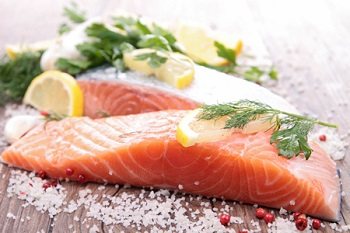
- Prevents the development of heart disease, reduces the likelihood of blood clots, which reduces the risk of strokes, Alzheimer's disease, and heart attacks.
- Makes the walls of blood vessels more elastic.
- Has a beneficial effect on the functioning of the nervous system. Mandatory in the diet of people suffering from depressive disorders, vegetative-vascular dystonia and other diseases of the central nervous system.
- Slows down age-related skin aging, improves the condition of the skin with atopic dermatitis and psoriasis.
- Strengthens the immune system. Eating weekly reduces the occurrence of complications during colds.
The vitamins contained in salmon have the following effects on the human body:
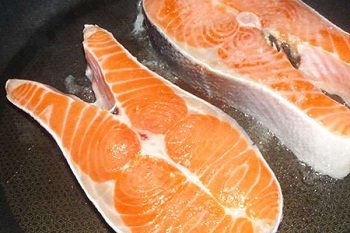
Contains a number of minerals:
- Potassium is an essential element for the functioning of the heart muscle, nervous system, and skeletal system.
- Sodium is an important substance for the normal functioning of the body, maintaining the acid-base balance for the normal functioning of the enzyme system.
- Phosphorus is responsible for the condition of human teeth and bones.
- Calcium is a microelement that is responsible for the functioning of the muscular and skeletal systems.
- Magnesium is responsible for the functioning of the heart, nervous system, and muscles. It is often prescribed for high mental and physical stress. It has a vasodilating effect and is involved in the separation of bile.
The chemical composition of salmon includes vitamins and minerals that promote better absorption of each other. This makes the product useful for many groups of the population.
The nutritional value
In terms of its chemical composition, salmon meat also deserves the name “red”, its nutritional and nutritional value is so high. This product contains a very diverse set of vitamins, minerals and other elements and compounds beneficial to humans. Moreover, their concentration is so high that it is enough to consume 1-2 servings of such a fish dish to satisfy the daily need for basic vital substances.
Proteins fats carbohydrates
All representatives of the salmon family, in terms of BJU ratio, belong to protein products with high fat content. The main share in the calorie content of red fish is occupied by fats, although proteins predominate in the overall composition.
Thus, fresh red fish with a calorie content of 152 kcal per 100 g contains:
Salted red fish contains 202 kcal/100 g of calories:
Smoked red fish contains 202 kcal/100 g of calories:
In marinated red fish, calorie content is 237 kcal/100 g:
In any case, the main advantage of salmon is that they contain large quantities of unique natural compounds - Omega-3 fatty acids. With a sufficient intake of such substances from food, the amount of cholesterol is maintained at a normal level, the blood vessels remain strong and elastic, and the brain and nervous system as a whole work perfectly. The results of scientific research have proven that people who often include salmon in their diet are 3 times less likely to suffer from cancer, hypertension and other cardiovascular diseases, and also have good memory and a stable emotional background.
Macro- and microelements
Biologically active fats are not the only advantage of representatives of the salmon family. Literally every component of their meat is of great benefit to humans, since it has a strong beneficial effect on internal processes. The following macroelements are especially active in this regard:
The microelements contained in salmon also have a rather powerful, pronounced effect on the human body. There are many more of them in number, but it is precisely this ratio that ensures the highest benefits of red fish. Among these elements it is worth highlighting:
Despite the relatively high calorie content of red fish, the wide variety and optimal combination of macro- and microelements, when consumed regularly in doses, helps restore metabolism and activate the burning of fat deposits, which generally helps accelerate weight loss. In addition, a powerful beneficial effect on almost all internal processes ensures the health of the body and a significant improvement in the emotional and mental state.
Vitamins
The balanced vitamin composition of salmon meat also plays a significant role in ensuring human health. Among these elements, the largest amounts are B vitamins, which are responsible for the state of the nervous system and proper brain function, which is very necessary for a modern person exposed to constant stress and overload. In addition, the vitamins of this complex help normalize the functioning of the endocrine and immune systems, improve the condition of absolutely all cells and participate in the functioning of the digestive organs. Salmon contains almost all representatives of this vitamin group, which further increases their beneficial properties, since individually these vitamins work less effectively. In particular, red fish contains the following:
In addition to B vitamins, salmon also contains other vitamins that are considered key markers of health and require daily replenishment through food. In red fish they are represented by the following elements:
Thanks to the indicated composition and variety of beneficial properties, red fish, when consumed correctly and regularly, helps to quickly improve health, strengthen the immune system, improve weight and appearance, preserving beauty and youth for a long time. But despite all the usefulness of such a product, it has some contraindications and limitations. First of all, they are associated with the presence of food allergies or individual intolerance to any seafood. In addition, the increased calorie content of red fish must be taken into account in the total energy value of the daily diet, especially when following a diet. It is also not recommended to consume salmon that is too fatty during periods of exacerbation of diseases of the gastrointestinal tract, so as not to create excess stress. In all other cases, moderate consumption of tasty and healthy red fish will have the most positive effect on your health.
Source
Is it possible during a diet?
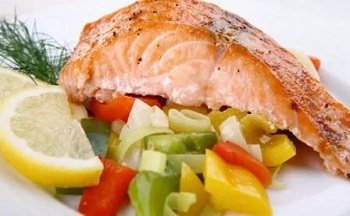
Salmon is prohibited during strict low-calorie diets
to achieve rapid weight loss.
However, it is indispensable with proper nutrition for a long-term weight loss effect.
Does not contain carbohydrates.
The polyunsaturated acids included in the composition promote the production of leptin, which is involved in metabolism.
70 g of fish per week can replenish protein, vitamins and minerals in conditions of limited nutrient intake during the diet.
It is not advisable to eat lightly salted or smoked fish.
Salt retains water in the body, increasing weight.
Application
Salmon is best known to a wide range of consumers in its smoked and lightly salted form. This is usually presented as a cold appetizer or delicacy. This fish is often present in salads and light snacks, and is used as a filling for rolls. Moreover, it can be purchased in ready-salted form or marinated at home with the addition of your favorite spices and seasonings.
But fresh Salmon has a distinct taste, from which it is customary to prepare delicate and appetizing creamy soups. This fish is also suitable for frying, and it can be combined with the most common and affordable products - side dishes, marinades, sauces. To preserve all the nutrients included in the product described, it is recommended to bake it on the grill or in foil in the oven.
Market Analytics
- 2020: an unprecedented test for the global cosmetics industry
- Top 10 Cosmetic Research and Development of 2021
- 2020 in the beauty industry – innovation without borders
Convenient search for beauty salons on our website
Beauty salons in Moscow Beauty salons in St. Petersburg Beauty salons in Ekaterinburg Beauty salons in Novosibirsk
Latest blog posts on our website
- Naturecream / Esterified oils
- Naturecream / Arnica - the magical plant of alchemists
- Naturecream / Tremella Extract - Snow Mushroom Detox for Skin
- Prostye-sovety / How to visually enlarge your lips with makeup
- Naturecream / Apricot kernel oil for face
- Naturecream / MATRIXYL3000 - the best skin elasticity stimulator
- Naturecream / SPF in Natural Oils
- Naturecream / Geranium (Pelargonium) oil for skin health and beauty
- Prostye-sovety / Save on a beauty salon: procedures that can be done at home
- Naturecream / Growth Factor - brings back youth?
Latest forum topics on our website
- Natalya / How to properly make a gelatin mask?
- Mrs._Smith / Badly sunburned! What to do?((
- Ice / Is it necessary to combine fitness classes with a diet?
- Antonova / What can be used for hair loss?
- Radio operatorKat / Who was on a protein diet?
Other articles in this section
| Stuffed pike perch Stuffed pike perch is a dish that has graced Russian cuisine for centuries. Pike perch is well suited for stuffing due to the low content of small bones in the fish. The dish is served at the festive table, and also serves as a good variety for a family dinner. The technology for preparing the dish is not complicated, so mastering it is not difficult. |
| Fried sea cucumber Sea cucumbers are commercially edible invertebrate animals, a species of echinoderm, from the class of sea cucumbers. The body is elongated, almost trapezoidal, slightly flattened at the bottom. They reach a length of over 40cm. Body weight can be about 1.5 kg. Life cycle 9-11 years. The main habitat is the coasts of Asia, Australia, Africa, and Russia. |
| Fried mussels Among the world's delicacies, such a nutritious, low-calorie product with a piquant taste as mussel has long been firmly established. They are boiled, pickled and eaten raw, but anyone who tastes fried mussels at least once will undoubtedly become a fan of this simple but delicious dish. Gourmets and aesthetes of sea food value mussels not only for their attractive appearance and unique aroma, but also for a wide range of useful substances. |
| Berix The Berix fish belongs to the order of perciform, deep-sea fish. Habitat is the Pacific and Atlantic oceans. Berix is widespread in Japan and off the coast of Southern Europe. It feeds mainly on planktonic animals. |
| Herring caviar Herring is often included in the human diet; it can easily be classified as an everyday food product. As for herring caviar, it is a kind of delicacy, and unlike expensive types of black or red caviar, it is more affordable and no less healthy. |
| Minced salmon The habitat of salmon fish is sea and fresh water in reservoirs located throughout the globe. Such fish are considered the most valuable in industrial fishing. Not only salmon fillet, from which excellent minced meat is made, is highly valued, but also high-quality and nutritious red caviar. |
| Fresh sea perch In nature, sea perch is found mainly in the Atlantic and Pacific oceans and belongs to the scorpion fish family. It prefers cold temperatures and depths of more than 100 meters to live. |
| Caspian sprat Caspian sprat is a small commercial fish of the herring family. It lives in the northern and southern parts of the coastal zone of the Caspian Sea. Outwardly it is very similar to herring, but much smaller in size. Representatives of this genus of fish are found in waters with low salinity and do not descend to a depth of below 40 meters. Avoiding temperature fluctuations, in winter they migrate to the south of the Caspian Sea, and in the spring and summer season they concentrate in the northern regions. Caspian sprat grows quite quickly and reaches a length of up to 17 cm, on average the length is 11-13 cm and the weight is from 8 to 10 grams. |
| Grayling Grayling belongs to freshwater fish of the Salmonidae family, subfamily Charisidae. This type of fish prefers to live in reservoirs with clean, flowing and well-oxygenated water. The distribution area is mountain rivers, fast streams and cold-water lakes in Europe, France and the north-eastern and northern parts of Russia, as well as in Siberia. At the same time, in Russia, grayling is one of the most beautiful and spectacular fish species. What gives the fish a special beauty is its large dorsal fin, which in appearance resembles a sailboat and reaches to the very base of the tail. |
| Pressed sturgeon caviar The number of fish of the sturgeon family on our planet is rapidly declining. Since the beginning of this century, Russian legislation has prohibited fishing for this most valuable fish in Russia. Already more than 10 species of the family are classified as rare. As a result, Canada and America took first place in sturgeon production. In Russia, special fish farms are being created where sturgeon are grown, but so far this is too little. But black caviar is a unique product, very important for all humanity. |
Use in cosmetology
Cosmetology companies actively use salmon caviar in the production of creams. It has a more concentrated amount of beneficial microelements and vitamins than meat.
Cosmetic products for nutrition and skin rejuvenation are made based on caviar extract.
, enhancing collagen production, developing anti-aging skin care lines.
In home cosmetology, neither salmon nor products made from it are widely used due to their high cost.
What is useful in medicine
Salmon is used to produce medicines to combat diabetes, pancreatic diseases, and hematopoiesis.

Widely used in prescribing therapeutic diets:
- in the rehabilitation period after exacerbations of cardiovascular diseases;
- for chronic respiratory diseases;
- cerebrovascular accidents;
- diseases of the bone and nervous systems.
If you have chronic diseases, you need to arrange 2-3 “fish days” per week
.
Use in cooking
Fish meat is tender and does not require lengthy cooking.
Boiled
How to cook:
- Wash the salmon pieces thoroughly under cool running water.
- Place the fish steak in a container of water, put it on the fire, and bring to a boil.
- Boil for 15 minutes.
- Add salt to taste.
Baked in the oven
Baking is an easy way to obtain tender fish with the most preserved vitamins and minerals.
For baking:
- Fish steaks 2-3 cm thick must be washed.
- Lightly pepper and salt on both sides.
- Place fish pieces on foil sprinkled with vegetable oil.
- Lightly sprinkle lemon juice on top, half a teaspoon of juice for each steak.
- Carefully wrap the foil to cover the top of the steaks.
- Place in a preheated oven.
- Bake for 15 minutes at 180 degrees.
Delicious snack
To create snack dishes, lightly salted or smoked fish is often used:
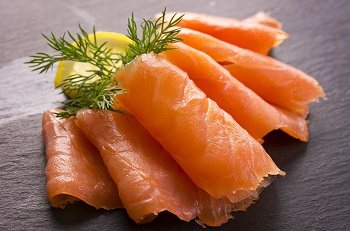
- Spread soft melted cheese thinly on a thin unleavened sheet of lavash.
- Arrange thinly sliced pieces of lightly salted salmon.
- Roll tightly to form a roll.
- Wrap with cling film.
- Place in the refrigerator for several hours.
- Remove and cut into portions.
- You can decorate by thinly slicing a fresh cucumber and twisting it into a rose shape on each piece of roll.
Fresh fish is available to residents of the fishing grounds.
More often it goes on sale frozen.
After purchasing frozen fish, the carcass or steaks are left in the refrigerator until completely thawed. This way, beneficial cellular juices will remain in the meat.
Whole fish are thoroughly washed, scaled, the head is cut off, gutted, cut into portions or salted whole or subjected to further culinary processing.
Boiling, steaming, grilling, baking allow you to quickly cook tender meat
, maintaining all the benefits without increasing the calorie content of the dish. It is recommended to eat salmon with vegetables for lunch or dinner, no later than 3-4 hours before bedtime.
It is advisable for a healthy person to include fish products in their diet 2 times a week, one of which is a fatty variety. The recommended 70-100 grams of salmon will cover half of the body’s daily requirement in proteins.
It is forbidden to consume more than 250 g per day due to the large amount of protein.
How else to cook salmon tasty and healthy, watch in this video:
Pickled
Marinated salmon (especially under the name salmon and pink salmon) is in stable demand due to its excellent taste and consumer qualities. This product is served as a stand-alone fish appetizer or used to make salads and sandwiches, and also baked in the oven, grilled or grilled. During the marinating process, the calorie content of red fish increases to 237 kcal per 100 g, since marinades based on sugar and vegetable oil are used with the addition of salt, lemon juice (or vinegar) and spices to taste.

Marinated salmon (trout) differs from salted salmon in a more pronounced spicy taste, which it transfers to culinary products when introduced into their composition. To marinate it yourself, rub 2 pieces of fillet with a mixture of 2 tbsp. l. sugar, 2 tbsp. l. coarse sea salt and freshly squeezed juice from 2 lemons. Place the pieces together, skin side out, wrap tightly in cling film, place in a container, press down on top with pressure and leave for 12 hours in a cool place. After the specified time, the fillets are washed, transferred to a deep bowl, poured in 200 ml of Extra Virgin olive oil and sprinkled generously with chopped onions. It is very important that the fish pieces are completely covered with oil and onions. Cover the dishes with cling film and put them in the refrigerator for 4 hours. The shelf life of this product is a maximum of 3 days.
Moderately fatty and elastic, but tender salmon meat has an excellent taste and a unique set of vitamins and minerals. Professional chefs claim that when prepared correctly, red fish is liked even by those who do not like fish dishes, and completely changes their attitude towards them. Salmon (trout) can be subjected to all methods of heat treatment, pickled, salted, canned and safely consumed raw. As a component of various recipes, it gives dishes a special taste and “status”, even if it increases their calorie content.
Boiled
If you choose a heat treatment option, the healthiest option is steamed trout (salmon). Boiled in water is also very useful, but a significant part of the valuable substances during such cooking goes into the broth, so this method is recommended for making soups. The calorie content of red fish in both cases is 149 kcal/100 g, which makes it an ideal component of the diet.
The advantage of steaming is the ability to treat fish pieces with various spices to give them your favorite flavor. To do this, the carcass or fillet is cut into small portions, salted, peppered, sprinkled with spices to taste, gently mixed and left for 10–15 minutes to soak. Then place on the grill of a steamer or multicooker, sprinkle with lemon juice and cook at moderate boil for 20 minutes. Take it out, let it rest a little and serve with greens. Such salmon will be juicy, aromatic and the most useful component of sports or dietary nutrition.
To boil in water, portioned pieces are immersed in boiling water, add onions, carrots, bay leaves, black peppercorns and other spices as desired. Cook over low heat for 15–20 minutes, depending on the size of the slices. Cool in the broth so that they absorb more flavor and remain juicy.
Baked
Despite the fact that the beneficial properties and calorie content of red fish most meet the requirements of a healthy diet after boiling in water or steaming, the most popular are not boiled, but baked fish dishes. They look much more attractive, have a more pronounced taste and are suitable not only for the daily menu, but also for the holiday table.

With cheese and mushrooms
Fillet is best suited for baking. You can buy it ready-made or cut a whole carcass into 2 parts yourself. It is most convenient to remove bones from meat when it is slightly frozen. You can bake the fillet whole or cut it into portions and place the filling and cheese on each separately. The calorie content of red fish with this cooking option will be 154 kcal/100 g. This parameter is not too high due to the addition of vegetables and mushrooms to the dish, which contain a small number of calories.
Before baking, fillets or slices with a total weight of 300 g are placed in a heat-resistant baking dish and sprinkled with a small amount of vegetable fat. Sprinkle with salt, pepper, spices. For the filling, fry 1 finely chopped onion and 1 grated carrot in a small amount of vegetable oil. At the end of frying, add 100 g of finely chopped mushrooms and bring until cooked. Spread the filling onto the fillet and level the surface. Sprinkle on top with a layer of 100 g of grated cheese. Bake in an oven preheated to 180ºC for 10-12 minutes. It is very important to adhere to the specified time, since the salmon flesh cooks quickly and if left too long, it can become dry.
Contraindications
It should be included with caution in the diet of people with allergies to fish and seafood. Obese patients, cholelithiasis, and people with kidney diseases should not overuse salted and smoked salmon.
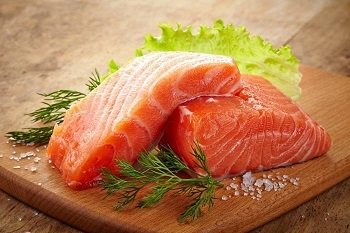
Fish grown in natural conditions has beneficial properties.
But in nature it is becoming less and less common.
Demand for salmon exceeds supply. Many suppliers grow it in equipped water areas. They are fed special food with additives to quickly gain muscle mass.
Artificially grown has a light shade of meat. Therefore, when feeding, dyes are added to add brightness to the pulp.
The amount of useful substances in such fish is much less than in wild fish.
Meat may contain residual amounts of additives that enter the body, putting stress on the liver.
Salmon is a healthy product that contains a number of vitamins, micro- and macroelements. It should be used by all groups of the population, except children under three years of age and obese patients, with kidney disease, gall bladder, and allergies. Possible harm can be caused by fish grown artificially.
CHEMICAL COMPOSITION AND NUTRITIONAL ANALYSIS
Nutritional value and chemical composition of “Salted salmon”.
The table shows the nutritional content (calories, proteins, fats, carbohydrates, vitamins and minerals) per 100 grams of edible portion.
| Nutrient | Quantity | Norm** | % of the norm in 100 g | % of the norm in 100 kcal | 100% normal |
| Calorie content | 202 kcal | 1684 kcal | 12% | 5.9% | 834 g |
| Squirrels | 22.5 g | 76 g | 29.6% | 14.7% | 338 g |
| Fats | 12.5 g | 56 g | 22.3% | 11% | 448 g |
| Water | 56.5 g | 2273 g | 2.5% | 1.2% | 4023 g |
| Ash | 8.5 g | ~ | |||
| Vitamins | |||||
| Vitamin A, RE | 30 mcg | 900 mcg | 3.3% | 1.6% | 3000 g |
| Retinol | 0.03 mg | ~ | |||
| Vitamin B1, thiamine | 0.15 mg | 1.5 mg | 10% | 5% | 1000 g |
| Vitamin B2, riboflavin | 0.2 mg | 1.8 mg | 11.1% | 5.5% | 900 g |
| Vitamin B4, choline | 0.731 mg | 500 mg | 0.1% | 68399 g | |
| Vitamin B5, pantothenic | 1.6 mg | 5 mg | 32% | 15.8% | 313 g |
| Vitamin B6, pyridoxine | 0.8 mg | 2 mg | 40% | 19.8% | 250 g |
| Vitamin B9, folates | 25 mcg | 400 mcg | 6.3% | 3.1% | 1600 g |
| Vitamin B12, cobalamin | 3 mcg | 3 mcg | 100% | 49.5% | 100 g |
| Vitamin C, ascorbic acid | 1 mg | 90 mg | 1.1% | 0.5% | 9000 g |
| Vitamin D, calciferol | 10.2 mcg | 10 mcg | 102% | 50.5% | 98 g |
| Vitamin E, alpha tocopherol, TE | 2.5 mg | 15 mg | 16.7% | 8.3% | 600 g |
| Vitamin K, phylloquinone | 0.5 mcg | 120 mcg | 0.4% | 0.2% | 24000 g |
| Vitamin RR, NE | 10 mg | 20 mg | 50% | 24.8% | 200 g |
| Niacin | 6.2 mg | ~ | |||
| Macronutrients | |||||
| Potassium, K | 221 mg | 2500 mg | 8.8% | 4.4% | 1131 g |
| Calcium, Ca | 40 mg | 1000 mg | 4% | 2% | 2500 g |
| Magnesium, Mg | 60 mg | 400 mg | 15% | 7.4% | 667 g |
| Sodium, Na | 2970 mg | 1300 mg | 228.5% | 113.1% | 44 g |
| Sera, S | 225 mg | 1000 mg | 22.5% | 11.1% | 444 g |
| Phosphorus, Ph | 243 mg | 800 mg | 30.4% | 15% | 329 g |
| Chlorine, Cl | 4477 mg | 2300 mg | 194.7% | 96.4% | 51 g |
| Microelements | |||||
| Iron, Fe | 2.5 mg | 18 mg | 13.9% | 6.9% | 720 g |
| Yod, I | 50 mcg | 150 mcg | 33.3% | 16.5% | 300 g |
| Cobalt, Co | 20 mcg | 10 mcg | 200% | 99% | 50 g |
| Manganese, Mn | 0.05 mg | 2 mg | 2.5% | 1.2% | 4000 g |
| Copper, Cu | 250 mcg | 1000 mcg | 25% | 12.4% | 400 g |
| Molybdenum, Mo | 4 mcg | 70 mcg | 5.7% | 2.8% | 1750 g |
| Nickel, Ni | 6 mcg | ~ | |||
| Selenium, Se | 36.5 mcg | 55 mcg | 66.4% | 32.9% | 151 g |
| Fluorine, F | 430 mcg | 4000 mcg | 10.8% | 5.3% | 930 g |
| Chromium, Cr | 55 mcg | 50 mcg | 110% | 54.5% | 91 g |
| Zinc, Zn | 0.7 mg | 12 mg | 5.8% | 2.9% | 1714 g |
| Sterols (sterols) | |||||
| Cholesterol | 108 mg | max 300 mg | |||
| Saturated fatty acids | |||||
| Saturated fatty acids | 2.3 g | max 18.7 g | |||
| Monounsaturated fatty acids | 4.15 g | min 16.8 g | 24.7% | 12.2% | |
| Polyunsaturated fatty acids | 5.11 g | from 11.2 to 20.6 g | 45.6% | 22.6% | |
| Omega-3 fatty acids | 4.14 g | from 0.9 to 3.7 g | 111.9% | 55.4% | |
| Omega-6 fatty acids | 0.864 g | from 4.7 to 16.8 g | 18.4% | 9.1% |
The energy value of salted salmon is 202 kcal.
Main source: Skurikhin I.M. and others. Chemical composition of food products. .
** This table shows the average levels of vitamins and minerals for an adult. If you want to know the norms taking into account your gender, age and other factors, then use the My Healthy Diet app.
Salmon in the diet of those who watch their figure
Regarding the form in which this fish is best eaten, there are no changes compared to other meat and seafood products. The most ideal thing is steaming. The calorie content of salmon cooked using a double boiler will reach 178 kcal, but due to the high protein content, even a hundred-gram piece will give you a feeling of fullness for a long time. You can supplement this lunch or dinner - the calorie content of steamed salmon and its overall lightness allow you to consume this dish at any time of the day - with vegetables or rice. Approximately the same picture will be for oven-baked fish, provided there is no fat in the form of butter or mayonnaise. The seafood itself can do without such additives: the meat will not become tough by the time it is ready. But if you wish, you can sprinkle it with lemon juice, which will benefit your slimness. As for how many calories are in salmon cooked in foil, this figure will stop at 102 kcal per hundred grams.
Among those products with which this fish works well in tandem, allowing you not only to avoid gaining excess weight, but also to burn hated fats, there are definitely cucumbers. Considering their satiety characteristics, we can say with confidence that the calorie content of steamed salmon with the addition of fresh finely chopped cucumber will seem ridiculous in comparison with how strongly such a combination repels the feeling of hunger. To enhance the effect, it is recommended to decorate the dish with herbs: parsley, dill or onion.
A rather exotic recipe, coming from the land of the rising sun, suggests combining salmon, soy sauce, cheese, avocado, lemon juice and sesame seeds. White short grain rice is used as a side dish. Despite the fact that a similar salmon dish has a calorie content of 215 kcal per hundred grams, it is perfect for both lunch and dinner. The trick is in the list of ingredients: lemon juice, sesame seeds and avocado perfectly break down fats and reduce weight, soy sauce is one of the most dietary, and the amount of Philadelphia cheese is not so critical as to panic. Rice, like fish, is present in almost all weight loss methods, since their relatively low calorie content is more than offset by their beneficial properties.
4.1 out of 5 (7 Votes)
Salmon fish, whose calorie content is relatively low - only 220 kilocalories per 100 grams of product, is one of the favorite dishes on the Russian table. And for good reason! There is an opinion that this fish is very nutritious, but this is not true. Therefore, salmon, whose calorie content will not harm your figure, is safely included in the daily diet, and it is also included in the dietary nutrition program. By the way, this fish does not have the ability to accumulate harmful substances in its tissues, which only emphasizes its uniqueness and usefulness. Like any red fish, it is prepared in various forms: salted, fried, pickled, smoked. However, at high temperatures, many beneficial substances are destroyed, so it is recommended to consume salmon smoked or lightly salted.
Salmon. Calorie content
For such a wonderful fish with such an appetizing name as salmon, calorie content is not the main criterion. Proteins, fatty acids, minerals, unsaturated fats and multivitamins give fish a special dietary value. Fatty acids, which regulate the amount of hormones that influence the processes of the circulatory system, have a beneficial effect on the human endocrine system. This means that by eating salmon it is quite possible to get rid of nervous stress and depression. Thanks to this nutritious product, blood circulation in the brain improves.
Lightly salted salmon. Calorie content
The calorie content of lightly salted salmon is practically no different from the calorie content of boiled or fried salmon. However, in this form (salty), it contains the well-known polyunsaturated fatty acid Omega-3, which can give an additional vital bonus to the body (prolongs youth). In addition, it restores damaged tissue, improves the functioning of the gastrointestinal tract, and significantly improves immunity. Salmon fats are not those that settle on the figure or create fatty deposits on the walls of blood vessels. In our case, fats are perfectly absorbed by the human body, which is accompanied by the release of a large amount of vital energy. By the way, the calorie content of salted salmon is 220 kcal. Not too much, right?
Compound
Salmon, whose calorie content is insignificant, contains in its tissues about 22 types of minerals that are simply necessary for our body: sulfur, calcium, magnesium, chlorine and others. This means that by eating salmon, you can improve the health of your hair and nails, as well as strengthen your bone tissue. Since salmon contains a large amount of vitamins, it allows for rapid recovery of strength after physical exertion.
Salmon caviar
Salmon caviar is considered very healthy, the calorie content of which is still slightly higher than that of the fish itself, amounting to 225 kilocalories per 100 grams of product. It is especially recommended for pregnant women. Through the mentioned product, biologically active substances enter the body. Red caviar also contains lecithin, which removes cholesterol from the blood and nourishes nerve endings.
Conclusion
In all types and respects, salmon is a healthy and tasty fish that will decorate any table.
Salmon is a delicious product. The taste qualities of this fish are appreciated by many gourmets. It is good fried, pickled, salted and smoked. This red fish is not only endowed with excellent taste, but it is also healthy.
Product calorie analysis
SHARE OF BZHU IN CALORIES
Ratio of proteins, fats and carbohydrates:
Knowing the contribution of proteins, fats and carbohydrates to calorie content, you can understand how well a product or diet meets the standards of a healthy diet or the requirements of a certain diet. For example, the US and Russian Departments of Health recommend 10-12% of calories come from protein, 30% from fat and 58-60% from carbohydrates. The Atkins diet recommends low carbohydrate intake, although other diets focus on low fat intake.
If more energy is expended than it is received, the body begins to use up fat reserves, and body weight decreases.
Try filling out your food diary right now without registration.
Find out your additional calorie expenditure for training and get updated recommendations absolutely free.
DATE FOR ACHIEVEMENT OF THE GOAL
Salted salmon
rich in vitamins and minerals such as: vitamin B2 - 11.1%, vitamin B5 - 32%, vitamin B6 - 40%, vitamin B12 - 100%, vitamin D - 102%, vitamin E - 16.7%, vitamin PP - 50%, magnesium - 15%, phosphorus - 30.4%, chlorine - 194.7%, iron - 13.9%, iodine - 33.3%, cobalt - 200%, copper - 25%, selenium - 66 .4%, chromium - 110%
- Vitamin B2
is involved in redox reactions, helps to increase the color sensitivity of the visual analyzer and dark adaptation. Insufficient intake of vitamin B2 is accompanied by impaired condition of the skin, mucous membranes, and impaired light and twilight vision. - Vitamin B5
is involved in protein, fat, carbohydrate metabolism, cholesterol metabolism, the synthesis of a number of hormones, hemoglobin, promotes the absorption of amino acids and sugars in the intestines, and supports the function of the adrenal cortex. A lack of pantothenic acid can lead to damage to the skin and mucous membranes. - Vitamin B6
is involved in maintaining the immune response, processes of inhibition and excitation in the central nervous system, in the transformation of amino acids, the metabolism of tryptophan, lipids and nucleic acids, promotes the normal formation of red blood cells, and maintaining normal levels of homocysteine in the blood. Insufficient intake of vitamin B6 is accompanied by decreased appetite, impaired skin condition, and the development of homocysteinemia and anemia. - Vitamin B12
plays an important role in the metabolism and transformation of amino acids. Folate and vitamin B12 are interconnected vitamins that are involved in hematopoiesis. A lack of vitamin B12 leads to the development of partial or secondary folate deficiency, as well as anemia, leukopenia, and thrombocytopenia. - Vitamin D
maintains calcium and phosphorus homeostasis and carries out the processes of bone tissue mineralization. A lack of vitamin D leads to impaired metabolism of calcium and phosphorus in the bones, increased demineralization of bone tissue, which leads to an increased risk of developing osteoporosis. - Vitamin E
has antioxidant properties, is necessary for the functioning of the gonads and heart muscle, and is a universal stabilizer of cell membranes. With vitamin E deficiency, hemolysis of erythrocytes and neurological disorders are observed. - Vitamin PP
is involved in redox reactions of energy metabolism. Insufficient vitamin intake is accompanied by disruption of the normal condition of the skin, gastrointestinal tract and nervous system. - Magnesium
is involved in energy metabolism, the synthesis of proteins, nucleic acids, has a stabilizing effect on membranes, and is necessary to maintain the homeostasis of calcium, potassium and sodium. A lack of magnesium leads to hypomagnesemia, an increased risk of developing hypertension and heart disease. - Phosphorus
takes part in many physiological processes, including energy metabolism, regulates acid-base balance, is part of phospholipids, nucleotides and nucleic acids, and is necessary for the mineralization of bones and teeth. Deficiency leads to anorexia, anemia, and rickets. - Chlorine
is necessary for the formation and secretion of hydrochloric acid in the body. - Iron
is part of proteins with various functions, including enzymes. Participates in the transport of electrons and oxygen, ensures the occurrence of redox reactions and activation of peroxidation. Insufficient consumption leads to hypochromic anemia, myoglobin deficiency atony of skeletal muscles, increased fatigue, myocardiopathy, and atrophic gastritis. - Iodine
is involved in the functioning of the thyroid gland, ensuring the formation of hormones (thyroxine and triiodothyronine). Necessary for the growth and differentiation of cells of all tissues of the human body, mitochondrial respiration, regulation of transmembrane transport of sodium and hormones. Insufficient intake leads to endemic goiter with hypothyroidism and slowing of metabolism, arterial hypotension, stunted growth and mental development in children. - Cobalt
is part of vitamin B12. Activates enzymes of fatty acid metabolism and folic acid metabolism. - Copper
is part of enzymes that have redox activity and are involved in the metabolism of iron, stimulates the absorption of proteins and carbohydrates. Participates in the processes of providing oxygen to the tissues of the human body. Deficiency is manifested by disturbances in the formation of the cardiovascular system and skeleton, and the development of connective tissue dysplasia. - Selenium
is an essential element of the antioxidant defense system of the human body, has an immunomodulatory effect, and is involved in the regulation of the action of thyroid hormones. Deficiency leads to Kashin-Beck disease (osteoarthritis with multiple deformities of the joints, spine and limbs), Keshan disease (endemic myocardiopathy), and hereditary thrombasthenia. - Chromium
is involved in the regulation of blood glucose levels, enhancing the effect of insulin. Deficiency leads to decreased glucose tolerance.
more hide
You can see the complete directory of the most useful products in the appendix - a set of properties of a food product, the presence of which satisfies a person’s physiological needs for the necessary substances and energy.
Vitamins
, organic substances required in small quantities in the diet of both humans and most vertebrates. Vitamin synthesis is usually carried out by plants, not animals. A person's daily requirement for vitamins is only a few milligrams or micrograms. Unlike inorganic substances, vitamins are destroyed by strong heat. Many vitamins are unstable and are “lost” during cooking or food processing.
Everyone knows that any fish is healthy. Many nutritionists and conventional doctors advise eating more fish and less meat. But, even if you are not a seafood lover, small amounts of these products should be consumed.
Of course, one of the most popular sea creatures is salmon. The calorie content of salmon is very high, and despite this, it is excellent for dietary nutrition.
Salmon contains a lot of useful substances. These are vitamins of group B, as well as A, C, D, E and PP. It also contains many trace elements such as sodium, phosphorus, potassium, fluorine, iodine, sulfur, chlorine and others.
Yes, this marine inhabitant is not low-calorie. However, due to the fact that it contains fats and proteins, but absolutely no carbohydrates, the dish you eat will not put extra centimeters on your waist.
Moreover, this product contains the Omega-3 amino acid and several other fatty acids, which promote the breakdown of fat and have an extremely beneficial effect on metabolism. The calorie content of salmon is quite high and yet it is perfect for people who want to lose weight.
In terms of its properties, this sea creature is simply a Goldfish. It is recommended for use by both children and adults. It will be useful for men and women, people engaged in mental work and workers with heavy physical activity.
Harm to salmon
Despite the fact that salmon is high in calories and contains a large amount of vitamins and minerals, not everyone can eat it.
People who have problems with high blood pressure and are overweight should not overuse lightly salted salmon. Its use can cause kidney failure and edema in such people.
You should also avoid buying salmon steaks that are too bright when cut. It is possible that they are tinted, and dyes are known to cause allergic reactions in many people.
Salmon is a favorite delicacy of many people. Its delicate, pleasant taste makes it an almost obligatory guest on a rich table, and its composition makes it an excellent dietary product that is incredibly beneficial for the body. You will learn how many calories are in salmon, and whether it can be included in the menu when losing weight, from this article.
Calorie content of fresh salmon
Fresh and lightly salted salmon, which is sold in vacuum packaging, has the same calorie content - 219 units for every 100 g. Most of the product is represented by proteins - there are 20.8 g of them, and a smaller part is fats: 15.1 g. There are no carbohydrates in salmon at all , and it is equal to zero (this information is relevant for those who suffer from diabetes).
The calorie content of salmon fillet, which can be purchased in stores, is usually 202 kcal. This product is often separated from the fattest parts, resulting in a lower energy value.
Calorie content of fried salmon
As a rule, after frying, foods become more nutritious, but in the case of salmon this does not work. During any heat treatment, fats are melted out of it, and its calorie content is reduced - from 219 kcal to 197 kcal.
If you bake salmon in foil, its calorie content will also be 197 kcal. Based on this, you can diversify your menu by eating this delicious fish in a variety of forms.
There will be even fewer calories in salmon if it is boiled - only 167 units. Therefore, salmon soup turns this fish into an excellent dietary product, incredibly healthy and tasty.
Is it possible to include salmon in a diet for weight loss?
Salmon is not only tasty, but also healthy. Its composition includes B, C, H, PP and D, micro- and macroelements - iodine, potassium, calcium, sodium, magnesium and many others. Added to this rich composition is the essential amino acid omega-3, which is not produced by the human body, which means it is important to obtain it from food.
Regular consumption of salmon can easily be included in a healthy nutrition system:
- Breakfast – oatmeal with apple, tea.
- Lunch – salmon fish soup, or salmon with vegetables and rice.
- Afternoon snack – a glass of kefir.
- Dinner – meat/poultry/fish with a side dish of vegetables.
Eating salmon during a diet allows you, even with a greatly reduced diet, to give the body everything it needs, so you will not experience such side effects of an incorrect diet as brittle nails, dull hair, problematic skin and pain of various origins.
A balanced diet is the key to not only health, but also slimness. With the correct distribution of proteins, fats and carbohydrates and normalized metabolism, rare breakdowns in favor of favorite “harmful foods” pass without painful consequences that drive depression. From the point of view of nutritionists, protein should be the basis in the menu of both a person losing weight and someone who is subject to serious physical activity. It is found in large quantities in meat and fish, and the latter category of products is often not for everyone. Those who have little understanding of the sea creatures that end up on the table will immediately name only herring, flounder and red fish, which seem to be an attribute of a holiday or good income. Salmon and salmon are the same “beast”, only with two names. It is served both salted and smoked, steamed, stewed and even fried. Combine with vegetables, dairy products, nuts, rice. This fish occupies a place of honor in dietary nutrition: despite its low calorie content, salmon has a high level of proteins and fats that are easily absorbed by the human body.
But those who adhere to strict diets that require constant counting of every crumb eaten should know the specific values of how many calories are in salmon. And that is not all. Since, with the same calorie numbers, the distribution of proteins, fats and carbohydrates, as well as the content of vitamins and microelements can vary, products of the same calorie content will have completely different effects on the figure. In addition, you can trick some of them by making them play by your own rules. How to do this with the calorie content of salmon is to be found out below.
Salmon danger
Of course, like any product, this fish has its contraindications. Not all people are recommended to eat it.
You should beware of red fish if:
- You have allergic reactions to salmon or seafood in general;
- You suffer from urolithiasis and kidney disease;
- you have liver problems;
- Have stones in the kidneys or gall bladder;
- You have inflammation in the gastrointestinal tract;
- You suffer from high blood pressure;
Briefly about the dishes
It is a well-known fact that heat treatment of any products deprives them of a certain part of their beneficial substances. The story is similar with this marine inhabitant. In addition, the calorie content of salmon depends on the method of its preparation.
Of course, each person has their own food preferences, but it’s still worth thinking about what exactly you eat and how beneficial it is for you and your figure.
Lightly salted and salted
The most popular dish is lightly salted salmon. In this form, it is most often found on store shelves. It is worth noting that such a product will be healthier than salted salmon.
After all, salted fish contains more salt, which in itself is not very healthy. After all, salt greatly retains water in the body, which can cause swelling. Also, salted salmon contains fewer beneficial properties.
Steamed dishes
Steamed salmon is the healthiest of all the dishes that can be prepared from this type of fish. But this is not news. It is a well-known fact that almost any steamed product will be healthier than, for example, fried. For people watching their weight, steamed food is a salvation and a great help in the process of losing weight.
And don’t worry that steamed food is not very tasty or bland. Today, there are many recipes for steamed dishes that even gourmets will like.
Boiled
Boiled salmon is quite beneficial for the human body in itself. Do not forget that liquid food has an extremely beneficial effect on metabolism. Of course, fish soup is not only a very tasty dish, but also extremely healthy.
In addition, boiled salmon has the lowest calorie content.
Fried foods
Fried fish contains the least amount of vitamins and microelements. If you are a big fan of fried foods, you should fry fish in butter or olive oil.
But still try to avoid eating any fried foods.
Salty
There are many options and methods for industrial processing or home cooking of salmon. But the most common of all foods and dishes is salted red fish. In this form, it retains all the valuable elements as fresh and has the same beneficial properties. This product is considered a delicacy and, as a component, makes any dish a culinary delight due to its excellent taste and attractive appearance. True, due to the high salt content, such salmon has more contraindications for consumption. If this factor matters, then it is better to give preference to lightly salted products and prepare them at home in order to know exactly the composition and volume of additives.
Calorie content of dishes
As mentioned above, the calorie content of salmon depends on the method of its preparation. It can be both extremely useful and quite harmful. But that's not all. After all, the amount of nutrients entering your body depends on what dish you eat. And the more benefits food brings you, the better.
- 100 grams of raw product - 204 Kcal;
- 100 grams of lightly salted salmon - 195 Kcal;
- Salted fish 100 grams - 205 Kcal;
- 100 grams of boiled product - 189 Kcal;
- 100 grams of fried food - 194.4 Kcal;
- 100 grams of steamed food - 197 Kcal.
It is impossible to say exactly how many calories there will be in a particular dish. After all, this parameter depends not only on the method of preparing the dish, but also on where its main ingredient was caught.
Fish caught in the sea has less calories than fish raised in special nurseries. This happens because the specially raised fish eats a certain food and moves very little. In nurseries it grows larger and therefore fatter.
Of course, salmon is an extremely healthy dish in our diet; it carries enormous benefits. It has an extremely beneficial effect on the human body, and the importance of rare amino acids simply cannot be overestimated. Omega-3 is an extremely useful amino acid that has a beneficial effect on many processes in the body. But nevertheless, we should not forget that everything is good in moderation. And you still shouldn’t overeat this product. Otherwise, you can not only get health problems, but also gain extra centimeters in the waist and gain unnecessary kilograms.
Salmon is a delicious product. The taste qualities of this fish are appreciated by many gourmets. It is good fried, pickled, salted and smoked. This red fish is not only endowed with excellent taste, but it is also healthy.
Calorie content of red fish

Red fish is a general consumer name for several species of the salmon family. Moreover, the word “red” indicates not only the color of the meat, but also its value. In Rus', this definition has long been given to everything rare, beautiful or of high significance. Previously, this category also included sturgeon, but today it is only chum salmon, salmon, pink salmon, sockeye salmon, whitefish, omul, char, nelma, lenok and some other salmon, best known under two collective names - salmon and trout. In any case, the chemical composition, beneficial properties and calorie content of red fish, hidden under all these terms, are almost the same and depend more on the time and place of catch, as well as on the method of culinary processing.
Calorie content of salmon and its benefits
In terms of calories, salmon is a low-calorie product. Its calorie content in raw form is about 219 kcal per 100 g of product. Moreover, it contains 20.8 g of protein, 15.1 g of fat and does not contain carbohydrates. Salmon often comes to our table in smoked or lightly salted form. The calorie content of lightly salted salmon is about 200 kcal per 100 g of product. The calorie content of smoked salmon is 169 kcal per 100 g of product.
The number of calories in salmon will decrease if this fish is steamed. The calorie content of steamed salmon will be about 153 kcal per 100 g of product. And if you prepare fish soup, the number of calories will decrease to 67 kcal per 100 g of product.
When frying, the calorie content of salmon increases significantly.
Considering how many calories there are in salmon, this red fish is the leader in fat content and content of useful components. It contains a lot of vitamins, fatty acids, unsaturated fats, and minerals. Salmon contains much more vitamins than other salmon fish.
When eating salmon, your mood improves and emotional stress disappears. Including salmon in the diet helps increase the elasticity of brain vessels and improve blood circulation. Salmon is a source of complete, easily digestible protein. Amino acids enter the human body from fish literally an hour after the start of digestion. Therefore, this product is necessary for restoring muscle tissue, skin, and also for strengthening hair follicles. It is especially useful to consume salmon for athletes and athletes, as well as during the recovery period after surgery. Considering that fish is usually consumed in small quantities, the calorie content of salmon does not affect the figure in any way.
Nutritionists and doctors recommend eating salmon to prevent senile dementia and diseases of the nervous system.
Fresh
Salmon (also known as salmon, trout and others) is a valuable commercial fish, which is considered a delicacy due to the combination of a refined delicate taste and a rich set of nutrients in the meat. Due to the increased fat content, the calorie content of red fish is also relatively high and averages 152 kcal per 100 grams of fresh carcass. But at the same time, it contains only high-quality, easily digestible proteins and valuable fish oil in the complete absence of carbohydrates. This makes salmon meat an optimal component of many diets.
Important! Unlike most types of fish, salmon is often eaten raw. In such cases, it is necessary to purchase only freshly caught sea or ocean fish, since it is salt water that prevents the development of parasites and bacteria.
The main rule is: the saltier the water, the lower the likelihood of harm to health. After all, even salmon caught in the almost freshwater Baltic or North Sea can be infected with the larvae of roundworms - anisakids.
The beneficial properties of all salmon are primarily due to the presence of Omega-3 polyunsaturated fatty acids, a number of valuable minerals and essential antioxidant vitamins. Thanks to this composition, regular consumption of red fish provides the following results:
With its high fat content and calorie content, red fish is a very useful product for people with excess body weight. The introduction of such a component into the diet 2-3 times a week, 150-200 g per day, will allow you to quickly get rid of extra pounds and reduce the symptoms associated with obesity. At the same time, the body will receive the maximum amount of useful macronutrients, vitamins and minerals.
The main culinary advantage of all salmon is the ability of their meat to practically not decrease in volume during heat treatment, while maintaining a moderately elastic structure and almost the entire complex of valuable elements. It should be taken into account that all the described properties are characterized only by high-quality products represented by fillets, steaks and carcasses in a fresh-frozen or chilled state. They should have elastic meat, a shiny surface and a natural fishy smell without foreign impurities.

